A whole book on Opus Anglicanum! An instruction book and a project book. Gosh! If you’re a lover of historical needlework, what more could you want?
Today, I thought I’d show you this new book on Opus Anglicanum by Tanya Bentham. It’s a practical guide the historical techniques of early English embroidery, and it is a fabulous book!
First, we’ll chat a bit about Opus Anglicanum and then delve into the book.
Come along…
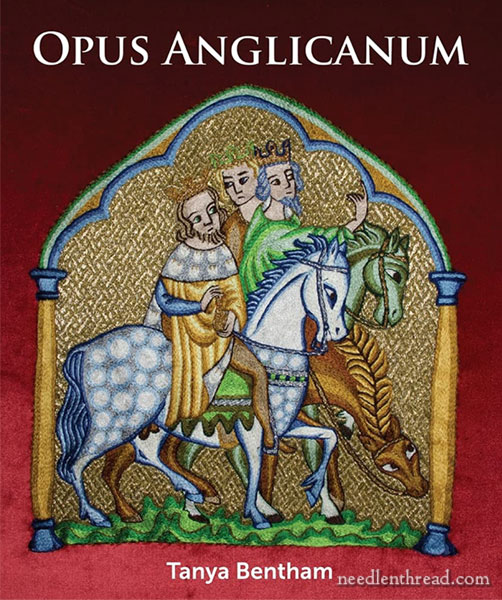
Opus Anglicanum (or “English work”) is the name given to the style of embroidery that developed in the Middle Ages and was predominantly mastered by the English. This isn’t surprising – England, Scotland, and Ireland were the seat and seed of art and culture in the west after the collapse of the Roman Empire and into the early middle ages.
Opus Anglicanum involves predominantly two types of stitching: split stitch (with silk) and couching – most specifically, undersided couching.
The early examples especially of Opus Anglicanum feature a unique style in its figures. If you are familiar with medieval illumination, you’ll recognize the look, although in embroidery, the “look” is even more pronounced.
The features on the figures are distinct. In the embroidered images, you’ll find large eyes and sometimes, seemingly disproportioned hands or feet. Figures are clothed in vivid colors, in robes shaded with split stitch.
Besides reflecting the style of art contemporary with the age, the exaggerated features and the boldness of the figures had a purpose. Like all religious art of the time, the embroidery told a story – and in order to “read” the story on embroidered pieces, you had to be able to see it from a distance.
The expression on a face is generally found first in the eyes, and the direction of the eyes tells us where a figure is looking – or maybe tells us where we should be looking to “read” the story. So the eyes were big. Hands and feet, which are the instruments of “doing” or indicating, are large. From a distance, figures were recognized by their symbolic accoutrements, by their expressions, and by what they were doing, looking at, or pointing towards – and their stories were told through gestures and expression.
There is something about the figures of early Opus Anglicanum that is appealing and timeless, even if we recognize them as belonging to a very specific age in history.
One of the great tragedies of needlework history is the fact that so many examples of Opus Anglicanum were destroyed during the 16th century. But the works and the records that still exist indicate that the skills required for Opus Anglicanum were mastered by the English embroiderers to such an extent that their work was appreciated all over Europe. Opus Anglicanum and the embroidered works that stemmed from the style profoundly influenced the development of embroidery throughout Europe, well into the Renaissance and beyond. It is a style of embroidery and art that deserves study.
And here we arrive at the book!
In her book, Tanya Bentham has given us a very practical guide to learning and working this type of embroidery.
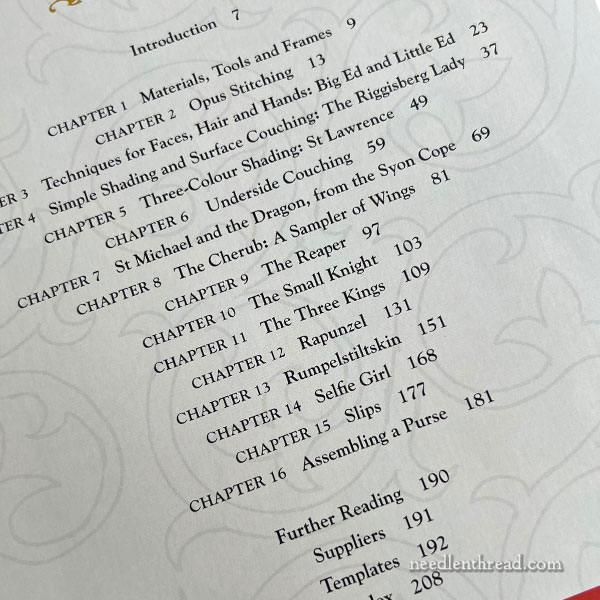
The book is divided into materials, general instructions, and projects. There are quite a few projects in the book that take the stitcher from simpler to more complex, in order to really learn the techniques and how to apply them in a design.
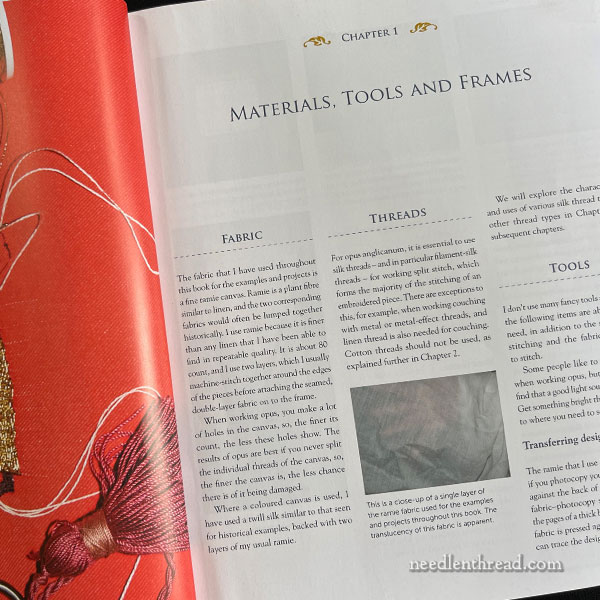
There’s not a vast array of materials needed for this type of embroidery. The thread of choice for the embroidery is flat filament silk. Tanya explains and demonstrates why this is so. Hint: it has to do with the play of light on the thread! You simply can’t get the same light play from cotton threads or from highly twisted threads.
If you’re unfamiliar with filament silk and flat silk, I’ve got a few articles about flat filament silks here on Needle ‘n Thread. This one would serve as a good introduction. There are plenty of links in there for further reading, too.
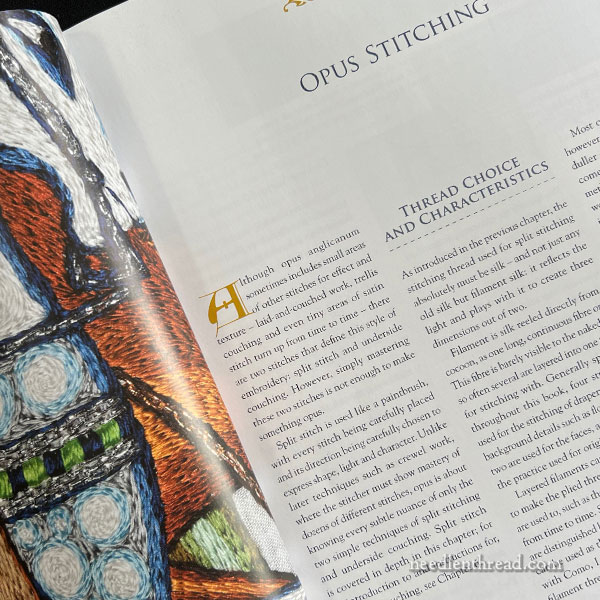
I think chapter 2, on Opus Stitching, is a really thorough chapter on the threads and stitches used in Opus Anglicanum. Split stitch is the star of this particular show.
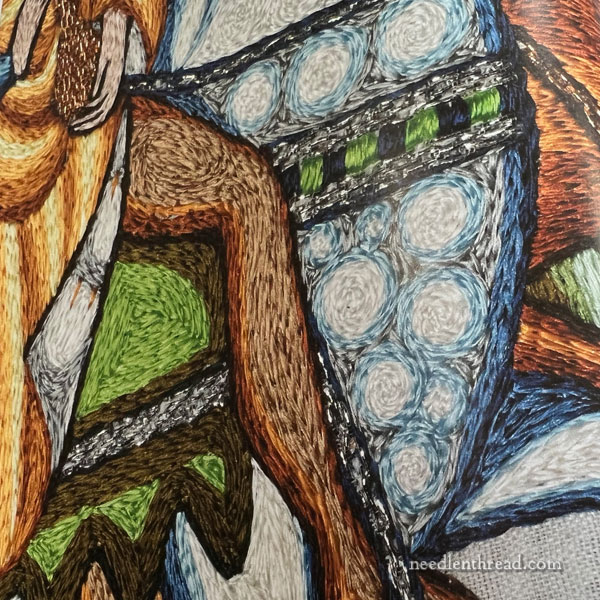
You’ll find a lot of lovely images of Tanya’s work throughout the book.
I’m partial to the close-ups.
One thing you’ll notice is that the stitching always has “movement” to it – the lines of stitching in Opus Anglicanum flow certain ways for a reason. It’s all bound up in the way the light plays on threads.
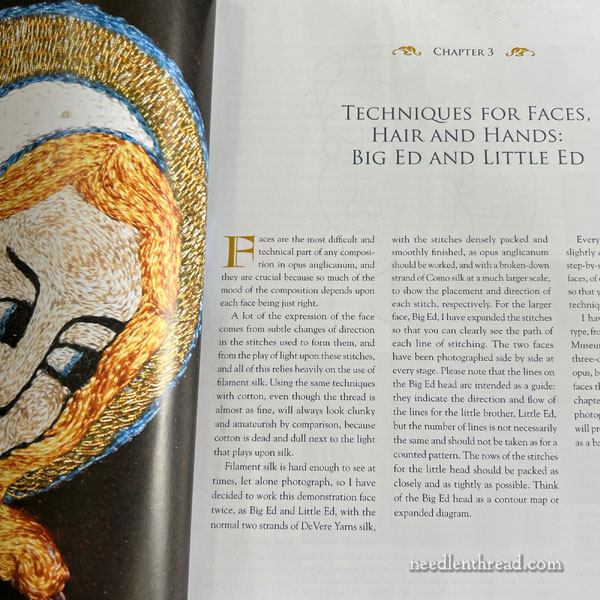
Tanya spends a good chapter on faces, hair, and hands. Big Ed and Little Ed are fabulous teaching tools for this chapter – well conceived, well done when it comes to instruction here.
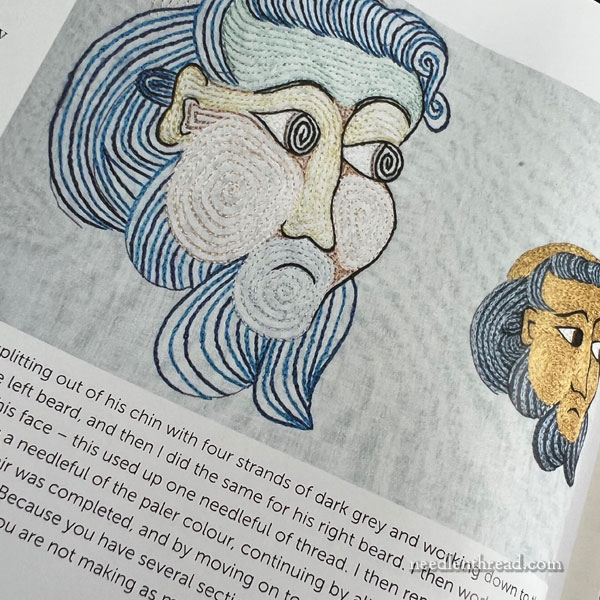
She uses an enlarged and ensmalled version of a head (Big Ed and Little Ed) to demonstrate the flow of stitching in Opus Anglicanum.
Big Ed essentially stretches out the paths that the embroidery takes when stitching a face and hair. It really is a well-done exercise and brilliant demonstration.
The flow of stitching in Opus Anglicanum is important to the whole style, so this chapter is a gem.
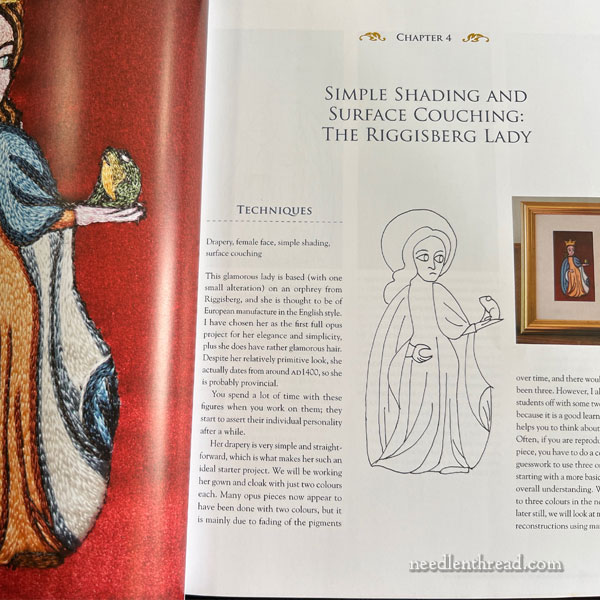
Through different small projects, Tanya takes the stitcher through the different concepts to master, starting with simple shading, and then moving forward in future projects to more complex shading.
Love the frog!
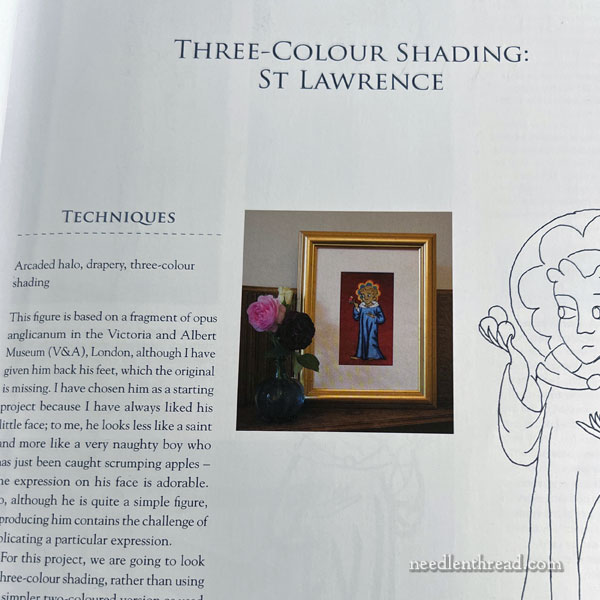
This is probably the only small glitch for me in the book. Most people probably wouldn’t notice it, or perhaps wouldn’t care. But I have a Thing for symbolism in art.
And just to come to the defense of poor overlooked St. Stephen…
This project – on three-color shading – is titled St. Lawrence.
In early Christian art, symbolism plays a dominant role. It goes back to that whole question of story-telling. The items that a figure holds or the setting around the figure contribute to the figure’s story, which is told not only for the edification of those reading the story, but also to hand down the story for future generations.
Tanya mentions that St. Lawrence was grilled to death and suggests that perhaps the little egg-shaped items this fellow is holding must be coals. In fact, they are rocks, because it is isn’t St. Lawrence (who is almost always depicted holding a grill or in the vicinity of a grill). It is St. Stephen, who is almost always depicted holding, or in the vicinity of, rocks, because he was stoned to death.
Here are the two of them in Christie’s Early English Embroidery:
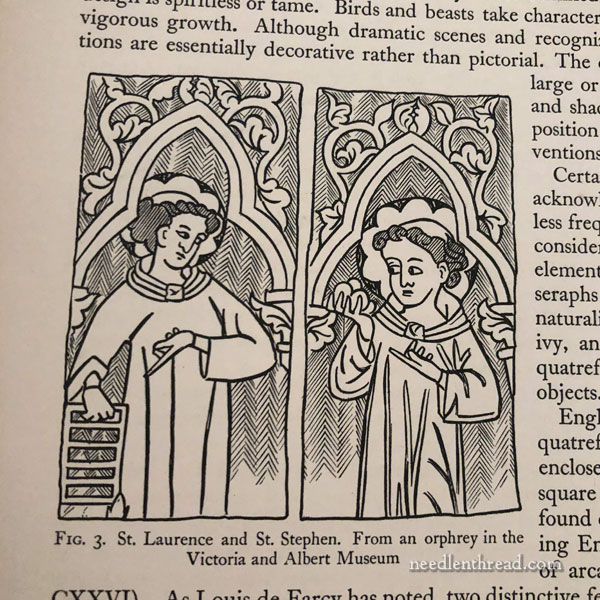
St. Lawrence is on the left, telling us his story about the grill; St. Stephen is on the right, telling us his story about the rocks. Notice, too, that he has a tonsure (the bare top of the head). The figure is tonsured because St. Stephen was a deacon. He is, in fact, the patron saint of deacons and stonemasons.
Like I said, symbolism is a Thing for me. I think it’s important. If we change the symbols, eventually we change the story – and it isn’t our story to change. So I’m kind of nitpicky about that kind of thing.
Regardless, the project is a wonderful demonstration on taking shading further, with three-tone shading.
Tanya clarifies that shading in Opus Anglicanum is done in these “blocks” of fewer shades rather than the many gradual shade changes which we see in later styles of embroidery.
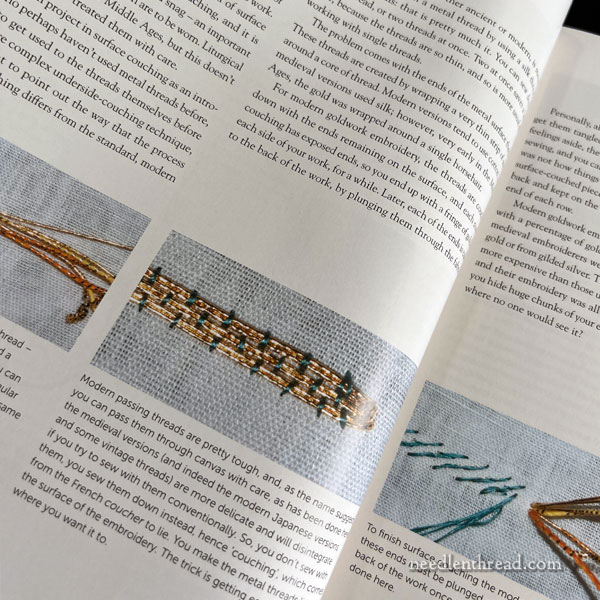
There is, by the way, much information on undersides couching, and many excellent step-by-step photo instructions to help the reader master the techniques and become proficient at it.
You’ll learn a lot about stitch length and positioning, as well as spacing, starting and ending threads, and, as the projects progress, working patterned backgrounds.
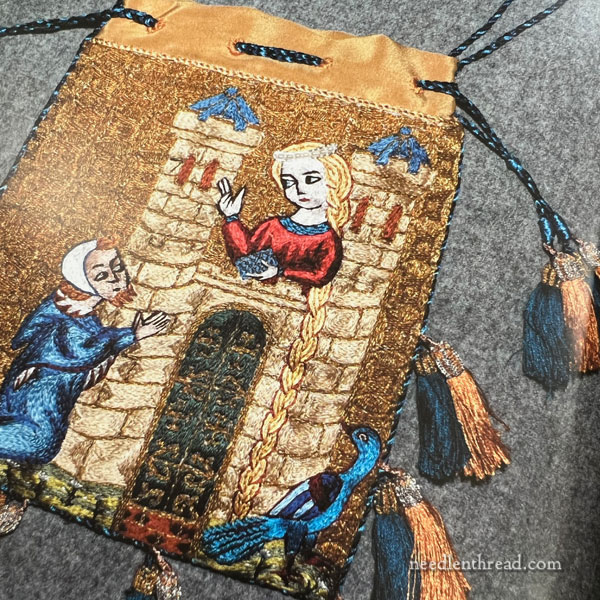
There are lots of projects in the book! And there are some suggestions for finishing (aside from framed pieces). I like this piece, depicting the story of Rapunzel, constructed as a bag.
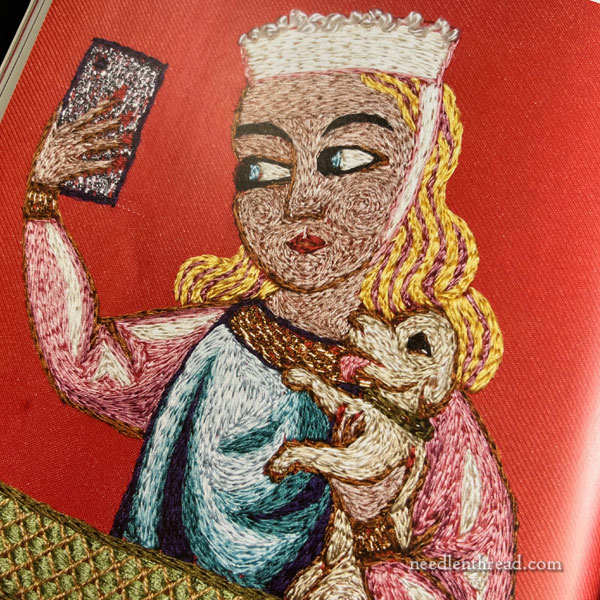
And yes, you can update Opus Anglicanum and bring it into the 21st Century! Selfie-girl is a hilarious example of just that, embodying the whole look of OA, but updated in subject matter. This is great!
In a Nutshell
What a fabulous book! It’s full of detailed, good instruction and fantastic projects that show us that Opus Anglican can be just as relevant today as it was a thousand years ago.
Tanya’s writing is easy to read. Her instructions – accompanied by many step-by-step photos – are accessible and easy to absorb.
I love the way the projects go from simple to more complex, so that you can learn and improve as you work through the book.
Not just for the historical embroiderer, Opus Anglicanum is an excellent instructional and project book.
Where to Find It
The book hasn’t been released in the US yet (it is slotted for next spring some time), so if you want it now, I’d suggest picking it up here through Book Depository. The price is significantly better, too.
This article contains affiliate links to book sources, which means that Needle ‘n Thread receives a small commission for purchases made through those links at no extra cost to you.







Howdy,
It is worth noting that the author of this book has a *delightful* blog where she talks a lot about designing and working Opus Anglicanum. She gives many of her little figures names and/or stories often pulls funny people and animals out of Medieval marginalia and stitches them up. It’s at https://opusanglicanum.wordpress.com
I have received my copy but have not read it yet. Thanks for the review and the reminder that this is a must read.
I have met Tanya a couple of times. Not only is she an excellent tutor (who makes great cakes for her students) but she is very entertaining. The inclusion of Selfie-Girl does not surprise me, in fact, it is exactly what you might expect from Tanya.
Oooh, yummy!
I generally take a pause, contemplate, put books on wish list and exert some self discipline. Not today, nope: went straight to Book Depository. Thanks, Mary!
P.S. So grateful your eyes are healing and will bring improvement!
Linda
Tanya also has the book available on her website. I ordered it directly from her a while back and she shipped it very promptly.
THankyou for the lovely review
( I have autographed copies on my website with shipping if anyone wants one! and I ship)
Thanks for the info on this book. I just had a look on Amazon UK for it and am amazed at how inexpensive it is. I was expecting it to be £40+ and it’s currently less than £15, reduced from nearly £20.
Definitely affordable so no excuses.
I love the easy-going, almost casual style of her writing. The information is all there and you somehow know she is an authority on the subject but it’s so easy to understand and she drops in little fun comments here and there that make you smile. I can imagine what she must be like in class. Follow her on Instagram–she has been showing some really neat new projects.
The mis-labeling of St Stephen bothered me also but I’m not familiar with St Lawrence so thought maybe it was just me.
And, if you want even more info on Opus Anglicanum take a look at “English Medieval Embroidery” edited by Clare Browne, Glyn Davies & M.A. Michael. I believe it is an exhibit catalog. It is huge, an inch thick(the paperback version) and filled with full page photos of embroidery. A lot of text also. I bought my copy along with Tanya’s book from The Book Depository.
Oooh, Mary, what a delicious morning read! And you could provide a picture of the two saints right there! I took Western Civ as a junior in college and have saved the textbook 50+ years. My audio book listening has gone all over the world in biography, ancient texts that did not get into our Christian Bible, history, etc. The old crafts must be preserved — at least so the youngsters can tell croshay from nit! [For awhile there, some magazine copy writers couldn’t!] On BBC this morning we see an experienced Irish worker making a cut glass goblet — and he is wearing a gorgeous knitted wool pullover with cables and all the lovely stitches I know about. I am at last succeeding in a bit of embroidery. It is counted cross-stitch from a tiny kit left in a bag of my neighbor’s things. I finished slippers for the neighbor, and she gave me the whole bag! The kit is from the ’80’s — a French country goose with a red bow on her neck — hokey at the time, high kitsch for now — and so soothing to work! In reading about flat silk, I marvel that there is a demand for this beautiful stuff, people to send for it and make lovely things with it. Thank you!
Talk about bringing Opus into the present. Have you seen her take on “The 3 Living and the 3 Dead”? It’s **fabulous**
You can see them (with progress pics) on either her blog or her Instagram.
I just HAD to buy a copy of this as soon as I saw it (I have an insane love for medieval marginalia)- it is fabulous, isn’t it? I am eagerly awaiting a clear work surface to do a project from it.
Oh no! Not another book!
I keep telling myself “no more”. Ha! As if…
I ordered it.
Thanks for the review Mary!
Well spotted, Mary! Although St Stephen and St Lawrence are brothers in martyrdom in Christian art, one should not confuse them. Regarding the place of Opus Anglicanum in a wider European context: too much credit to the English. You’ve completely cut out the Byzantine empire :). Early Opus has hardly any silk embroidery in it and was practised in France and Germany too. Its style clearly comes from further East with foliage, animals and Byzantine-style rulers dominating the designs. And the influence of embroidery made in England was long over by the start of the Renaissance. By then, the embroiderers working in England were migrants from the Continent who took their embroidery techniques with them. Many pieces were directly imported from the Continent. Embroideries from the Low Countries were now traded all over Europe. Sorry for being so picky, but by constantly emphasising the unique nature of Opus we lose the bigger picture. And it leads to the later pieces in English (and some US) museum collections being neglected and not getting the proper conservation attention they need.
Yes, the Byzantine influence on all Christian art cannot be neglected if one wants a thorough and deep view – which is really hard to delve into, in a 1500-word book review.
To get at the real meat of the matter, it would require exploring pre-Christian art, Judaic influences, Eastern influences, and into the earliest days of iconography, if you want to connect all the threads and show a consistent line up to medieval art. But by the so-called “Dark Ages” in Europe, it was partially out of Britain that art and culture grew again and began to flourish, with the French (Charlemagne) borrowing scholars and artists from the Isles and other places, to disseminate learning, culture, art, etc. from his court. Although they weren’t the only places where art was flourishing, Iona and Jarrow were among the earliest centers of learning in western Europe. As is the case with any but the most isolated culture, though, as the various parts came together – whether it was because of raiding or brawling among kingdoms or exploration, etc. – bits of culture were adopted and amalgamated into what would eventually become the art of the Middle Ages, and then the Renaissance, and then… and on and on and on. So many threads of influence on not just needlework, but on all art, architecture, music, literature, culture, science, philosophy … as is always the case, through the whole history of the world.
While I enjoy Lanto Synge’s book, even it – as thorough as it seems to be – misses some influences and connections on early needlework or downplays the importance of others. It is an inevitable part of being human, I suppose, with all our limitations.
I’d love to see someone take a precise timeline of human history (on a global scale!), and write a history of needlework along that timeline, highlighting developing techniques, materials, and so forth and then making connections between the different cultures as techniques were exchanged and disseminated. It would be MASSIVE. Massive. It could never be done by one person in one lifetime. LOL! But gosh. It would be Something.
TGIF, everyone! There’s a tie-in here with Fruity Knitting! The latest post from those precious ladies is a trip around Yorkshire — and they ran into Tanya at a festival! Meet Tanya, see her work, hear more about her book. This was filmed the end of September. https://www.youtube.com/watch?v=Q_dPADri4Ik
I received my copy today and will get over my disappointment soon, I hope. The type is so small that I may have to use a magnifying glass to read it. The photos, in general, are of good size. But in general, still a bit of a disappointment.
Dear Mary
Wow this looks wonderful and a very good book to own, I love the pictures of the people with their big eyes it would be interesting to stitch the different people. There seems to be so much in the book and I always like photo instructions I find them easier to follow. Very expressive projects and I looked at the price and very reasonable for such a good instructional book. Thank you for sharing with us the Opus Anglicanum – Book I would like to purchase this in the future.
Regards Anita Simmance
So glad I got back to your site again. I changed email address from (edited out) to my current one so missed out on you most of last year! Please add me to your mailing addresses. I was so glad to see your hexie quilt has grown since I last tuned in. I hope you are well and am glad to see so many treasures on your site.
Paula
Hi, Pauline – Thanks for your comment! You’ll need to visit the website at http://www.needlenthread.com To subscribe to the newsletter. You will find the subscription form in the left column on the website. Thanks a bunch!